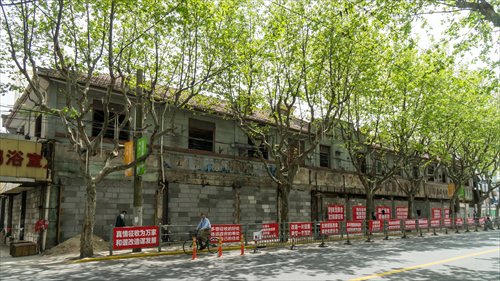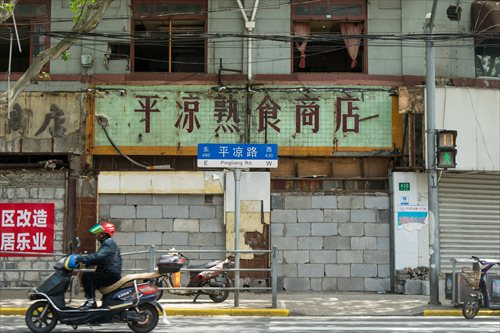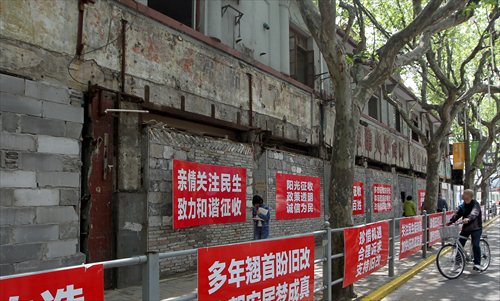HOME >> METRO SHANGHAI
Another Shanghai historical neighborhood meets the wreckers
Source:Global Times Published: 2016-4-27 17:18:01
Badaitou is an old area in the southwest Yangpu district that used to be a prosperous, popular neighborhood, a showplace for Shanghai's lilong (laneway) homes and markets. But this century old area is about to vanish as demolition crews move in and residents move out.
In 1908, the Roman Catholic Church built eight blocks of two-story apartments on today's Tongbei Road near Pingliang Road. This was the original Badaitou and that was apparently how the area was named. In the Shanghai dialect Badaitou is the way people would say eight blocks.
Before China's reform and opening up, Badaitou was known as the Nanjing Road of Yangpu district.
It was a thriving area of department stores, cinemas, barber shops, photo studios, churches, and pawn shops. By the end of the 20th century, Badaitou was also one of the city's most popular seafood streets with stalls and restaurants along Tongbei Road offering a vast variety of fresh seafood dishes.
The relocation program started in 2005 and affects more than 16,000 residents and 369 businesses, the news site eastday.com reported in October 2015. According to the Shanghai Observer, this year, six neighborhoods on Pingliang Road will be moved - more than 5,000 households.

Recent demolition work uncovered many of the older shop signs which had been hidden under modern business banners and hoardings. Many passers-by have been pausing to take photos of these old memories - "Universal Radio Store", "Pingliang Cooked Food Store" and "Pingliang Muslim Restaurant."

Badaitou was Mrs Liu's home for 60 years - her great grandparents had moved there more than 100 years ago. "I am hoping to record the old things and preserve the memories with my camera. Badaitou has a long history, and it would be sad if I didn't learn its story," Mrs Liu said.
She is actually quite knowledgeable about Shanghai's history and her own experiences have added to this knowledge.
"My great grandmother lived in Xinkangli before liberation. These apartments were built as dormitories for the staff of the Ewo Cotton Spinning & Weaving Co., Ld. Besides, one of the founders of the Heng Foong Cotton Mfg. Co., Nie Qigui in the Qing Dynasty (1644-1911) made many contributions to this area."
Farewelling the past
Most of the residents in Badaitou nowadays are elderly Shanghainese who have spent half a century here. The demolition and relocation means a farewell to their past lives, their neighbors, homes and friends.
Zhang Xiulan (pseudonym) is in her 80s and she has no idea when her apartment will be demolished, but having lived in Badaitou for more than 70 years, she hopes it could be later rather than sooner.

Nowadays Zhang is living by herself in her old apartment on the ground floor. Like other residents still waiting to be relocated, she spends a lot of time sitting in her doorway, watching people passing by. Some of her neighbors were relocated six months ago.
As well as the friends and neighbors, Zhang also misses the Zhuangyuan Lou Restaurant, an old eatery that used to be on the intersection of Tongbei and Pingliang roads. "I was a regular at the Zhuangyuan Lou Restaurant when it was still going. Sweet and sour spare ribs, sliced cold chicken, yellow croaker with pickles soup - it was authentic food and it was cheap," she said.
Relocation bonuses
Although there are still people waiting to be relocated, nearly two-thirds of the residents and businesses have moved. According to residents, signing a relocation agreement early can mean a bonus of 6,000 yuan ($923).
Retired taxi driver Mr Zhu, who has been living in Badaitou with his wife for more than 30 years, said: "Some people are content with the bonus, so they move quickly. It will be some time before it is our turn to move. I don't mind moving - the living and sanitary conditions here are now awful."
He said a lot of young people were still coming to the area for dinner and midnight snacks before the stalls and restaurants are demolished and there were others playing mahjong and singing karaoke loudly - residents suffered from the noise every evening.
"Though most of the new relocation apartments are in Songjiang district and Nanhui area, I don't mind living far from downtown. We know that the suburbs are developing rapidly and I think I will have enough time to get used to the new life," Zhu said.
The new Badaitou will bring few surprises. Jiang Zhongwei, the now retired deputy director of the Annals Office of Yangpu District told the Youth Daily in 2015: "When the demolition is finished, Badaitou will be transformed into a center for recreation, shopping, catering and business."
The article was written by Qu Xinyi
Newspaper headline: Bulldozing the memories
In 1908, the Roman Catholic Church built eight blocks of two-story apartments on today's Tongbei Road near Pingliang Road. This was the original Badaitou and that was apparently how the area was named. In the Shanghai dialect Badaitou is the way people would say eight blocks.
Before China's reform and opening up, Badaitou was known as the Nanjing Road of Yangpu district.
It was a thriving area of department stores, cinemas, barber shops, photo studios, churches, and pawn shops. By the end of the 20th century, Badaitou was also one of the city's most popular seafood streets with stalls and restaurants along Tongbei Road offering a vast variety of fresh seafood dishes.
The relocation program started in 2005 and affects more than 16,000 residents and 369 businesses, the news site eastday.com reported in October 2015. According to the Shanghai Observer, this year, six neighborhoods on Pingliang Road will be moved - more than 5,000 households.

New red signs encouraging residents to cooperate with the demolition are put up as the older shop signs are uncovered. Photo: CFP
A hidden historyRecent demolition work uncovered many of the older shop signs which had been hidden under modern business banners and hoardings. Many passers-by have been pausing to take photos of these old memories - "Universal Radio Store", "Pingliang Cooked Food Store" and "Pingliang Muslim Restaurant."

The old sign of "Pingliang Cooked Food Store" is shown. Photo: CFP
Mrs Liu (pseudonym) and her family had lived in the area and she returned with the specific intention of taking photos of the old signs and bric-a-brac that had been uncovered. Her great grandmother and the family used to live in the Xinkangli neighborhood. Most of those buildings are now just rubble although a broken doorplate could be seen clearly.Badaitou was Mrs Liu's home for 60 years - her great grandparents had moved there more than 100 years ago. "I am hoping to record the old things and preserve the memories with my camera. Badaitou has a long history, and it would be sad if I didn't learn its story," Mrs Liu said.
She is actually quite knowledgeable about Shanghai's history and her own experiences have added to this knowledge.
"My great grandmother lived in Xinkangli before liberation. These apartments were built as dormitories for the staff of the Ewo Cotton Spinning & Weaving Co., Ld. Besides, one of the founders of the Heng Foong Cotton Mfg. Co., Nie Qigui in the Qing Dynasty (1644-1911) made many contributions to this area."
Farewelling the past
Most of the residents in Badaitou nowadays are elderly Shanghainese who have spent half a century here. The demolition and relocation means a farewell to their past lives, their neighbors, homes and friends.
Zhang Xiulan (pseudonym) is in her 80s and she has no idea when her apartment will be demolished, but having lived in Badaitou for more than 70 years, she hopes it could be later rather than sooner.

A man stops by to check the old "Pingliang Muslim Restaurant." Photos: Yang Hui/GT
When the Global Times asked her how she felt about moving her eyes filled with tears. "I really don't want to leave. People have feelings," Zhang said. She felt that life in Badaitou 30 years ago was much better than today's existence. "Unlike today's dirty cluttered streets, the old Badaitou was clean and people who walked on the streets then were honest and upright."Nowadays Zhang is living by herself in her old apartment on the ground floor. Like other residents still waiting to be relocated, she spends a lot of time sitting in her doorway, watching people passing by. Some of her neighbors were relocated six months ago.
As well as the friends and neighbors, Zhang also misses the Zhuangyuan Lou Restaurant, an old eatery that used to be on the intersection of Tongbei and Pingliang roads. "I was a regular at the Zhuangyuan Lou Restaurant when it was still going. Sweet and sour spare ribs, sliced cold chicken, yellow croaker with pickles soup - it was authentic food and it was cheap," she said.
Relocation bonuses
Although there are still people waiting to be relocated, nearly two-thirds of the residents and businesses have moved. According to residents, signing a relocation agreement early can mean a bonus of 6,000 yuan ($923).
Retired taxi driver Mr Zhu, who has been living in Badaitou with his wife for more than 30 years, said: "Some people are content with the bonus, so they move quickly. It will be some time before it is our turn to move. I don't mind moving - the living and sanitary conditions here are now awful."
He said a lot of young people were still coming to the area for dinner and midnight snacks before the stalls and restaurants are demolished and there were others playing mahjong and singing karaoke loudly - residents suffered from the noise every evening.
"Though most of the new relocation apartments are in Songjiang district and Nanhui area, I don't mind living far from downtown. We know that the suburbs are developing rapidly and I think I will have enough time to get used to the new life," Zhu said.
The new Badaitou will bring few surprises. Jiang Zhongwei, the now retired deputy director of the Annals Office of Yangpu District told the Youth Daily in 2015: "When the demolition is finished, Badaitou will be transformed into a center for recreation, shopping, catering and business."
The article was written by Qu Xinyi
Newspaper headline: Bulldozing the memories
Posted in: Metro Shanghai, City Panorama